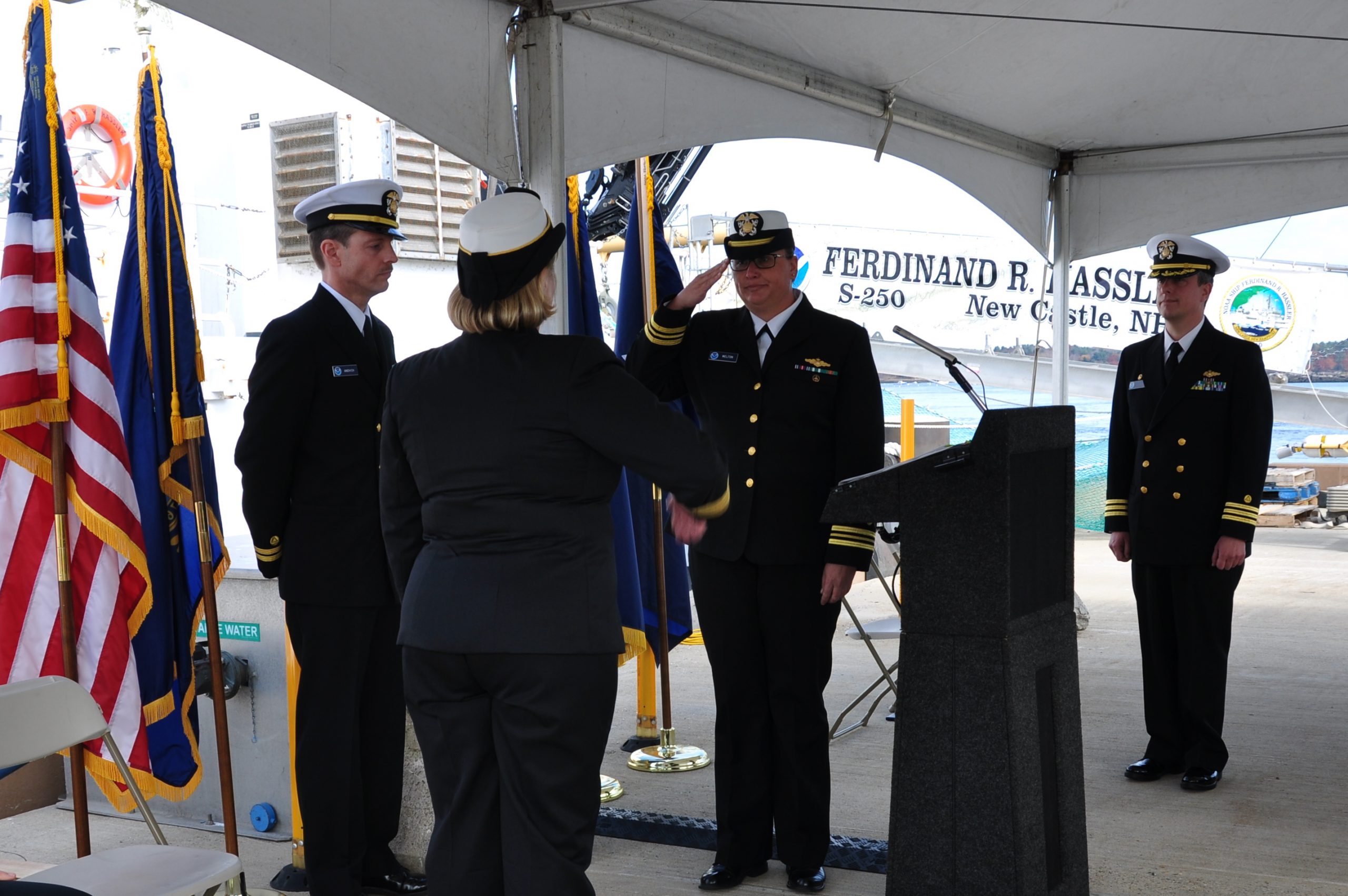The crew of the NOAA Ship Ferdinand R. Hassler (S-250) hosted a change of command on November 5, while moored at its homeport in New Castle, New Hampshire.
In front of the crew and guests – including Rear Adm. Gerd Glang, director of the Office of Coast Survey, and Capt. Anne Lynch, commanding officer of the Atlantic Marine Operations Center – Lt. Cmdr. Briana Welton accepted command of Hassler, replacing Cmdr. Marc Moser.
Welton is the new survey ship’s third commanding officer.

Glang congratulated Welton on her new responsibilities. “You have proven yourself capable and successful in your previous assignments, and we have great expectations you will continue to succeed at your new command-at-sea,” he said.
A commanding officer of a NOAA survey ship is also the ship’s hydrographer, chief scientist, and senior program representative. This means that, in addition to being responsible for the safe management of the vessel, the ship’s CO is also solely and ultimately responsible for the completion of the science mission: the hydrographic surveys that are delivered to Coast Survey.
The event marked the end of a successful tour for Moser, who served as Hassler’s second commanding officer, beginning in December 2013. Glang commended Moser for his service as “a resilient, resourceful, and extremely competent leader.”
During Moser’s tenure, Hassler achieved significant reductions in survey processing time, which cut an average of 55 days from the time it takes to get newly acquired data on to nautical charts.
Highlighting the importance of working to minimize conflicts with commercial fishing operations during survey projects, Glang thanked Moser for coordinating with the local fishing communities in the Gulf of Maine and adapting survey schedules to try to avoid impacts on fishing operations. Moser also demonstrated his “understanding and commitment to the customs and traditions of a seagoing service, when Hassler intercepted a derelict sailing vessel that had been drifting for three days in the New York Bight,” Glang pointed out. The crew facilitated the vessel’s rescue by the U.S. Coast Guard.
Moser succeeded Cmdr. Ben Evans, who brought Hassler through its delivery and initial shakedown period and into operations – including responses to hurricanes Irene and Sandy. In the Sandy response, Hassler searched for dangers to navigation and sped the resumption of shipping and naval traffic through deep draft routes to the ports of Hampton Roads and Baltimore.

Welton, who has served as Hassler‘s executive officer since May 2014, congratulated Moser for his successful command, and then went on to “thank everyone here – and those who couldn’t be here, too – who have supported this ship through all the trials and tribulations of transforming a newly constructed ship of unique design to a safe and effective operational ocean mapping vessel.”
Welton received her commission in 2003, and is one of a growing number of females in the NOAA Corps, one of the nation’s seven uniformed services. Of the total 320 officers, 91 are women. NOAA’s female percentage of 28.4 compares favorably to 14.5 percent of the active-duty military force, and 10.5 percent of the U.S. Coast Guard total force of active-duty and reserve personnel. (See CNN, By the numbers: Women in the U.S. military, January 24, 2013)
NOAA Ship Ferdinand R. Hassler is a small waterplane area twin hull (SWATH) vessel designed for improved stability. Hassler’s officers, technicians, and scientists acquire and process the hydrographic data that NOAA cartographers use to create and update the nation’s nautical charts with ever-increasing data richness and precision.
The ship was named for Ferdinand Rudolph Hassler, a visionary scientist who planned the survey of the coast after President Jefferson signed enacting legislation in 1807. Hassler became the first superintendent of Coast Survey, serving until his death in 1843.

News and Updates
